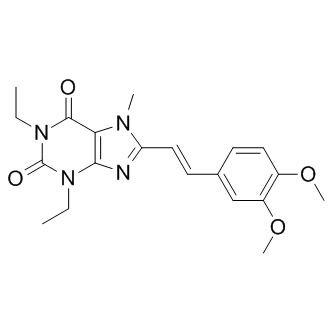| Description: |
Istradefylline is a very potent, selective and orally active adenosine A2A receptor antagonist with Ki of 2.2 nM in experimental models of Parkinson's disease. |
| In Vivo: |
Istradefylline (3.3 mg/kg, i.p.) treatment before a single dose of MPTP attenuates the partial dopamine and DOPAC depletions measured in striata 1 week later[1]. Istradefylline reverses CGS21680-induced and reserpine-induced catalepsy with an ED50 of 0.05 mg/kg and 0.26 mg/kg, respectively. Istradefylline is over 10 times as potent in these models compared to other adenosine antagonists and dopamine agonist drugs. Istradefylline combined with L-dopa cuases potent effects on haloperidol-induced and reserpine-induced catalepsy[2]. Istradefylline (10 mg/kg, p.o.) results an increase in locomotor activity to approximately twice that of control and improves motor disability in MPTP-treated common marmosets. Istradefylline (10 mg/kg, p.o.) in combination with SKF80723, quinpirole, or L-DOPA produces a significant additive effect on locomotor activity and improvement of motor disability but not dysKinesia[3]. |
| In Vitro: |
Istradefylline has 70-fold greater affinity for the A2AR than the A1 receptor with Ki of 2.2 nM versus 150 nM[1]. Istradefylline causes concentration-dependent abolition of bFGF induction of astrogliosis in primary rat striatal astrocytes[4]. Istradefylline binds to A1 receptor, A2A receptor, and A3 receptor in human with Kis of >287 nM, 9.12 nM, and >681 nM, respectively, 50.9 nM and 1.57 nM for A1 receptor and A2A receptor in rat, 105.02 nM and 1.87 nM for A1 receptor and A2A receptor in mouse, respectively[5]. |






















